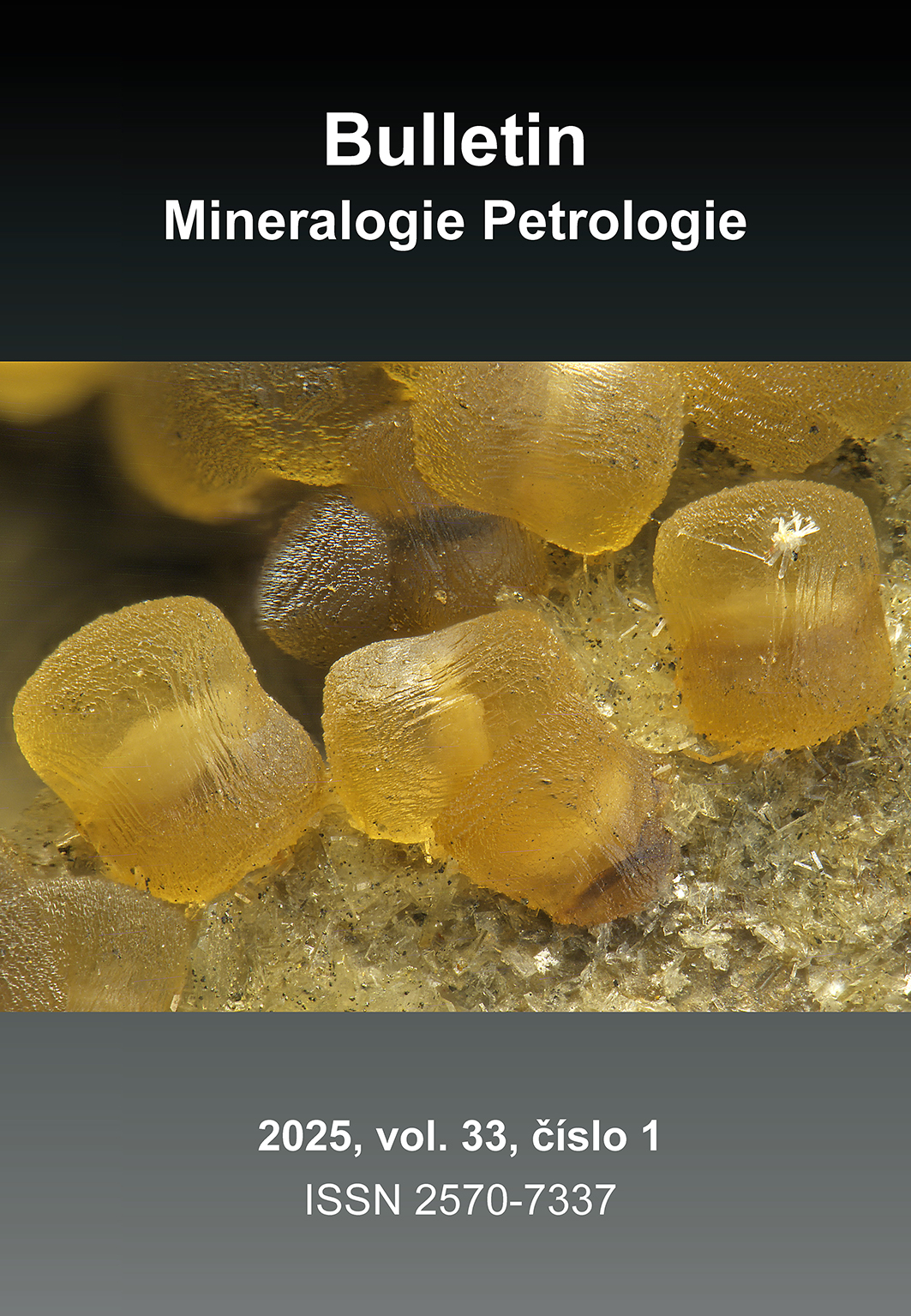Slags and iron from experimental smelting of iron realized at the Buchlov Castle (Chřiby Mts., Czech Republic) in 2018
Keywords
Abstract
During experimental smelting of iron in a replica of historical shaft furnace, which was held at the Buchlov Castle in 2018, charcoal and Mn-enriched pelosiderite-limonite iron ore from the locality Strážovice near Kyjov were used. The obtained furnace slag is practically completely formed by glass phase; only rare small domains also contain olivine. The glass phase is compositionally heterogeneous and contains 0.7 - 10.7 wt. % MnO, whereas olivine corresponds to fayalite with elevated contents of tephroite (ca. 12 mol. %), forsterite (ca. 4 mol. %) and dicalciumsilicate (1 mol. %) components. The produced metallic iron is also compositionally heterogeneous, rich in phosphorus and in places it contains small spherical inclusions of pyrrhotite. The phase composition of slag differs significantly from those of typical iron slags. The reason can be seen either in anomalous chemical composition of used ore (the elevated contents of Mn could potentially act as an inhibitor of crystallization), or in too high temperatures during smelting (the phase relations in metallic iron suggest temperatures exceeding 1500 °C) in combination with rapid cooling of the furnace content after finishing of smelting. Both phase composition of slag as well as chemical composition of individual slag phases and metallic iron are significantly different from those of local historical artefacts from the period of usage of technology of direct production of iron. These findings do not support the idea that local pelosiderite iron ores were used for production of iron already during this early period.
Files
References
Bachmann HG (1982) The identification of slags from archaeological sites. Occasional publication No. 6, Institute of Archeology, London
Barák M (1995) Experimentální výroba železa v peci z doby Velké Moravy. MS, diplomová práce, VUT Brno
Burkart E (1953) Mährens Minerale und ihre Literatur. Nakl Čs Akad věd, Praha
Dolníček Z, Čudrnáková K (2014) Charakterizace struskových hmot z Dražůvek u Kyjova. Geol výzk Mor Slez 21: 81-84
Dolníček Z, Kandrnál L, Ulmanová J, Vratislavská E, Hojač P (2019) Historická těžba pelosideritů na lokalitě Koryčanská cesta u Moravan, jižní Chřiby. Bull Mineral Petrolog 27: 304-316
Dolníček Z, Kandrnál L, Ulmanová J, Vratislavská E, Hojač P (2020) Mineralogická charakteristika fosforitové konkrece s rodochrozitem z lokality Tabarky, severní Chřiby. Bull Mineral Petrolog 28(1): 35-43
Donaldson CH (1976) An experimental investigation of olivine morphology. Contrib Mineral Petrol 57: 187-195
Dykyj J (ed) (1953) Fysikálně chemické tabulky I. Stát nakl tech lit, Praha
Kapusta J (2013) Mineralogie a chemismus strusek po tavbě stříbrných rud z vybraných lokalit v jihlavském rudním revíru. MS, diplomová práce, PřF UP Olomouc
Kolbinger D (2011) Výzkum těžebních a zpracovatelských areálů v Hostýnských vrších a jejich podhůří. Archeol Mor Slez 11: 206-219
Kruťa T (1966) Moravské nerosty a jejich literatura (1940 – 1965). Moravské museum. Brno
Křivánek J (2009) Inventarizace výskytů historických železářských strusek v oblasti Chřibů. MS, bakalářská práce, PřF UP Olomouc
Křivánek J (2015) Mineralogické studium artefaktů po železářské výrobě z vybraných lokalit v okolí Starého Města u Uherského Hradiště. MS, diplomová práce, PřF UP Olomouc
Okamoto H (1990) The Fe-P (iron-phosphorus) system. Bull Alloy Phase Diagr 11(4): 404-412
Pleiner R (1969) Experimental smelting of steel in early Medieval furnaces. Pam Archeol 60: 458-487
Pleiner R (2000) Iron in Archeology: The European Bloomery Smelters. Archeologický ústav AV ČR, Praha
Pouchou JL, Pichoir F (1985) “PAP” (φρZ) procedure for improved quantitative microanalysis. In: Armstrong JT (ed.) Microbeam Analysis: 104-106. San Francisco Press, San Francisco
Rawdon HS (1917) Some unusual features in the microstructure of wrought iron. Technologic papers of the Bureau of Standards 97: 1-25. https://doi.org/10.6028/nbst.3260
Souchopová V (1986) Hutnictví železa v 8.-11. století na západní Moravě. Stud Stát Archeol Úst ČSAV v Brně 13, 1, 109 pp, Academia Praha
Stewart JV, Charles AJ, Wallach E (2000) Iron–phosphorus–carbon system: Part 3 – Metallography of low carbon iron–phosphorus alloys. Mater Sci Technol 16(3): 291-303. https://doi.org/10.1179/026708300101507857
Stránský K, Souchopová V, Ludikovský K (1978) Pokusné tavby na přímou výrobu železa z rud v šachtových pecích na Blanensku. Slévárenství 26(11): 464-467
Stránský K, Souchopová V, Merta J (2000) Rekonstrukce pochodů přímé výroby železa z rud. Archeol techn 11: 12-21
Svoboda R (2014) Charakterizace železářských strusek z pokusné tavby realizované Technickým muzeem v Brně v r. 2012. MS, bakalářská práce, PřF UP Olomouc
Zmeškalová B. (2010) Mineralogické studium artefaktů po železářské výrobě v okolí Bystřice pod Hostýnem. MS, diplomová práce, PřF UP Olomouc
